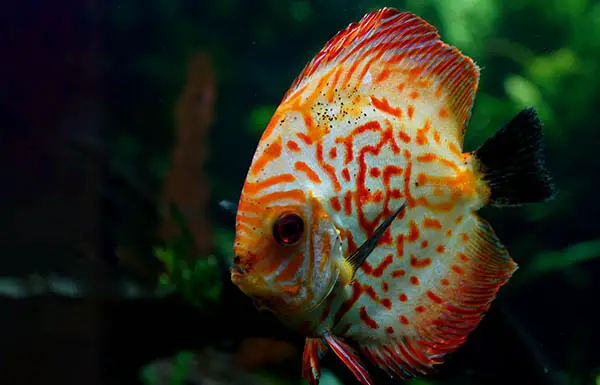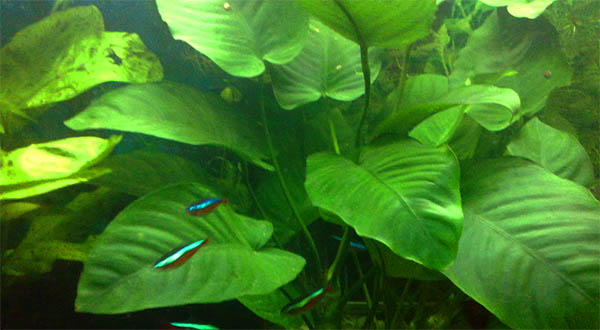Aquascaping is fashionable to an extreme. I can’t look at my Instagram feed without seeing yet another incredible fish tank. As a result, some of us might feel bummed out when no matter how hard we try, we just can’t quite get our tank to look nice.

https://commons.wikimedia.org/w/index.php?curid=3478300
10 gallon aquarium.
Well, don’t beat yourself up about it; because, the aquascapes you see online are created by people with years of experience. Not only that, they’re spending big on the right equipment: lighting, CO2 systems, substrate, and fertilizers.
I can’t promise you an easy way to an A+ aquascape, but what I can do in this aquascaping guide is give you three easy tips. This is a quick and easy read that’ll give head start to getting an aesthetic for your aquarium that you can be happy with.
These are some tricks that might elude experienced and newbie fishkeepers alike.
3. Paint the back of the tank a solid color!
The first tip I have for you is to paint the background of your aquarium a solid color.
Painting the background of your fish tank a solid color provides a base on which the colors of your fish will “pop”.
Black is a good choice because it provides a feeling of depth in the water, it’s also a nice choice for brightly colored fish as it gives some nice contrast. Black is my go to color for the back of my aquariums; it’s an inoffensive color and has that classic look.
Royal blue is another popular choice, it reminds us of the cerulean expanse of a clean lake or the rolling waves of the ocean. It too can be a nice color for fish to pop against. If you have dark colored fish, blue is going to be a better choice than black which could camouflage your fish.
Think long and hard before using other colors, they tend not to look as natural as blue or black.
I’ve made mistakes using whatever paint I had sitting in my carport shed. For example, I used a very light color and it ended up causing the color in my shubunkin goldfish to “wash out”. Lots of fish change their color based on their environment, in the case of calico goldfish, they tend to get lighter in a lighter environment.

It can go the other way though. For example, with discus, “peppering” is undesirable and is brought out by a darker background. For this reason, many discus keepers go for a much lighter background color.
Oh, and remember, paint the outside of the tank not the inside. I know you already knew that, but I’ve heard stories!
2. Pick Easy Plants
If you want a lush green tank but you’re not ready to take the plunge with expensive lighting, fertilizers, and CO2 systems, than give yourself a break and go for easy plants.

Anubias is a hardy plant that you can buy just about anywhere. It’s an excellent plant for aquascape beginners and experts alike. You can buy quality aquarium plants directly through Amazon now! Check them out (affiliate link).
Anubias comes in many varieties and will do well in lower light conditions. More than that, it’s practically indestructible, as it tastes foul to all but the most ravenous of herbivorous fish. Goldfish will eat just about anything green that they come across, but they won’t eat anubias.

Java fern falls into the same category as anubias. There are a few different species to choose from. Again, none of the species available mind lower light conditions. It’s also comes with an objectionable taste to most fish and as a result it will be ignored.
What’s great about both java fern and anubias is that they are both readily available. Most fish stores will have multiple varieties of both of these plants to choose from.
1. Rule of Thirds vs. Golden Ratio
This is the most important tip of the lot. Following the rule of thirds or the golden ratio is the key to getting your aquarium looking fantastic. If you don’t get this right, there’ll always be something “off” about the way your aquarium looks.
Rule of Thirds
This is an idea we’ve borrowed from photography, so any snap happy readers might already be well aware of this.
So, let’s start with the rule of thirds.
The rule of thirds proposes that we divide an image—or in this case, an aquarium—into nine segments. These segments are all equally sized and divided by two horizontal lines and two vertical lines. Don’t worry too much about that explanation; for a quicker understanding of the concept just have a look at the images below.

https://commons.wikimedia.org/w/index.php?curid=1084823
You can see how the tree comprises the main component of the image, while the horizon follows the lower line. The plants growing out of the water in the bottom left provide something interesting in those sectors.
The above is an animated gif, it shows how the positioning of the major elements in that photograph make it appealing to us as human observers.

Now, the image above shows exactly how we can divide a ten gallon aquarium into nine segments in the same way a photographer would frame or crop their photo.

So, ideally you want your main decorative feature to take up a chunk of the space in the 5, 6, 8, and 9 segments.

Once you have your main decorative feature occupying that space, it’s good to go with a smaller feature that takes up the space of segment seven—it can also straddle the line between seven and eight.

After you have the main features in place, you can begin to build the rest of your aquascape around them, e.g. you can position plants and smaller rocks to create lines and areas of space that help define the lines of the rule of thirds.
Golden Ratio
The golden ratio has some complex junk behind it, and we’re going to completely ignore it because it just isn’t relevant to getting your aquarium to look awesome. That, and also because I’m honestly not particularly qualified to explain the golden ratio.

All I know is that when you take your inspiration from the above pattern overlayed on the aquarium then you can come up with some of the most aesthetically appealing aquascapes.
When you follow the golden ratio for aquascaping, you want your main feature to mimic the inner swirl if at all possible. To do this you can use rocks, caves, or even the right shaped piece of drift wood. Then arrange other features and plants to follow that swooping outer line.
Conclusion
I hope these little tips help you get your tank and its aquascape looking nice. I haven’t gone into too much detail because for beginners or casual aquascapers like me who just want their aquarium to look quite nice this is all you’ll need to know.
If you do enjoy it and want to expand on the hobby and get deeper into it then this info should provide you with a good starting point.
Consider following me on Twitter and Instagram. I use my Instagram to post cool pictures of aquarium fish every single day—even Christmas and my birthday! On Halloween I might be too busy eating candy sooooooo…
And lastly, if you found this aquascaping guide helpful, please consider sharing it with your friends or on your social media accounts. All help is appreciated.
Thanks For Reading
Thanks for reading! If you appreciated this content, then check out my recommended foods. I put together a great list of some of my favorite foods. Check it out here.




